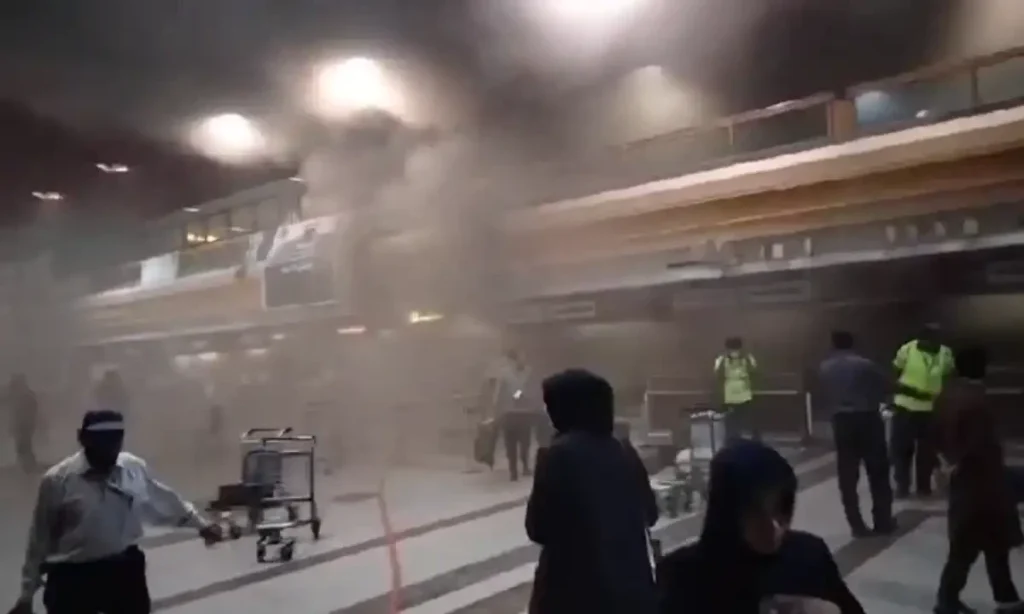In the early hours of July 16, 2025, a massive fire erupted in the cargo terminal of Allama Iqbal International Airport, Lahore, setting off a rapid and large-scale emergency response. The blaze, which caught fire crews and airport staff off guard, quickly transformed the cargo area into a chaotic scene of smoke, heat, and flashing lights as authorities mobilized to contain the situation.
Sudden Outbreak and Rapid Emergency Response
Around 10:30 a.m., an urgent alarm triggered action among emergency personnel. Rescue 1122 received an immediate distress call and dispatched eight firefighting and rescue vehicles to the airport’s cargo section. Within minutes, firefighters and first responders arrived on the scene and established perimeter cordons, evacuating airport staff working nearby. The air was thick with smoke and the roar of hoses filled the atmosphere as crews fought to prevent the blaze from spreading to aircraft, fuel storage, or adjacent airport buildings.
Ongoing Firefighting and Containment Efforts
Firefighters worked tirelessly to douse the intense flames that had engulfed part of the cargo warehouse. Several teams penetrated deeper into the terminal to chase and extinguish hot spots and smoldering debris. Around the perimeter, others allowed controlled venting of heat and smoke. The cargo shed, packed with crates, pallets, and breakers, posed a significant challenge. Responders remained vigilant against flashover risks and structural collapse while ensuring water supply lines remained continuous.
Authorities confirmed that no casualties have been reported so far, and initial assessments indicate minimal structural damage beyond the cargo area. Although airport flights continued operating under diverted routes, the airport’s Cargo Terminal A was temporarily sealed off. Airports Authority teams diverted operational staff and issued interim travel guidance to freight companies.
Investigative Measures and Cause Assessment
The precise cause of the fire is still under investigation. Airport officials and CAA engineers suspect a possible electrical short-circuit in the cargo handling zone might be to blame, but a detailed forensic inquiry will follow once the flames are fully put out. Surveillance footage, electrical logs, and personnel witness accounts are being collected for analysis.
In parallel, airport security was ramped up. The Pakistan Airports Authority coordinated with provincial police to activate emergency protocols, install temporary checkpoints, and raise safety protocols across all terminals. Support teams liaised with airlines and freight handlers to reroute shipments and redesign unload schedules as clearing operations took place.
Broader Implications for Safety and Infrastructure
This fire incident highlights the vulnerabilities of aging airport infrastructure and the cargo terminal’s exposure to hazards such as electrical surges or human errors. Lahore Airport, Pakistan’s third-busiest and handling over 86,000 tons of cargo annually, is a critical node in national logistics. Any threat to its operations can have wide-reaching effects on exports, import logistics, and transit connectivity.
The incident has reignited calls for enhanced fire safety protocols, including:
- Routine inspections and regular maintenance of electrical wiring in storage and handling zones
- Improved installation of fire detection systems such as smoke alarms and heat sensors
- Upgraded emergency exit routes, signage, and fire suppression equipment
- Structured training exercises for airport and cargo staff to ensure readiness
- Efficient communication channels between Rescue 1122, CAA, and cargo line operators
Recovery and Next Steps in Restoration
In the coming days, teams from the Civil Aviation Authority, airport operations, cargo handlers, and insurers will assess the damaged area. A phased restoration plan includes:
- Completion of fire suppression and cooling of affected metal structures
- Detailed safety inspections to confirm structural integrity
- Electrical rewiring and replacement of damaged wiring
- Gradual reopening of cargo operations with enhanced safety measures
Flight schedules and cargo operations will continue to follow temporary adjustments until systems are fully cleared. Cargo clients are advised to coordinate with airlines to avoid delays or reroute high-value shipments.
Conclusion
While the massive fire at Lahore Airport’s cargo area sparked genuine alarm, swift firefighting efforts have largely contained the threat. The absence of casualties is a welcome relief. However, the incident underscores the pressing need to strengthen airport infrastructure safety, especially within cargo handling zones that often lie outside passenger-facing vigilance.
Authorities now face the task of turning this crisis into an opportunity upgrading equipment, systems, and staff preparedness to ensure that Lahore Airport remains a safe, reliable, and efficient pillar of Pakistan’s transport and trade ecosystem.



Comments (0)
No comments yet. Be the first to comment!
Leave a Comment